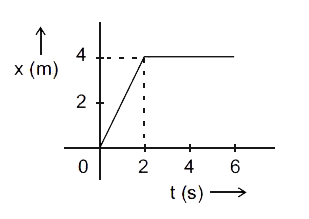Shown the position time graph of a particle of mass 4 kg What is the force on the particle for t<0,0<t<4s motion only
 .
.
(a) (i) for t<0 the position time graph is AO which means displacement of the particle must be zero
(ii) for 0<t<4s the position time graph OB has a constant slope Therefore velocity of the particle is constant in this interval i.e particle has zero acceleration Hence force on the particle must be zero
(iii) For t>4s the position time graph BC is parallel to time axis Therefore the particle remains at a distance of 3 m from the origin i.e., it is at rest Hence force on the particle is zero
(b) Impulse at t=0
We know impulse = change in linear momentum Before t = 0 particle is at rest i.e. u = 0
After t = 0 particle has a constant velocity υ=34=0.75m/s
∴ Impulse =m(υ−u)=4(0.75−0)=3kgms−1
Impulse at t=4s
Before t = 4 s particle has a constant velocity u=0.75m/s
After t = 4 s particle is at rest i.e., υ=0
∴ Impulse =m(υ−u)=4(0−0.75)=−3kgms−1.
Topper's Solved these Questions
- LAWS OF MOTIONBook:PRADEEPChapter:LAWS OF MOTIONExercise:Additional Examples / Exercises
Explore 6 Videos
- LAWS OF MOTIONBook:PRADEEPChapter:LAWS OF MOTIONExercise:Short Answer Questions
Explore 35 Videos
- LAWS OF MOTIONBook:PRADEEPChapter:LAWS OF MOTIONExercise:Advanced problems for competitions
Explore 20 Videos
- KINEMATICSBook:PRADEEPChapter:KINEMATICSExercise:1 NCERT Comprehension
Explore 4 Videos
- MATHEMATICAL TOOLSBook:PRADEEPChapter:MATHEMATICAL TOOLSExercise:Fill in the blanks
Explore 5 Videos
Similar Questions
Fig. shows the position-time graph of a particle of mass 4 kg. What is the (i) force acting on the particle for t<0,t<4s,0<t<4s? (ii) impulse at t = 0 and t = 4 s? Assume that the motion is one dimensional.
View SolutionFig. shows the position-time graph of a particle of mass 4 kg. What is the (i) force acting on the particle for t<0,t<4s,0<t<4s? (ii) impulse at t = 0 and t = 4 s? Assume that the motion is one dimensional.
View Solution
Knowledge Check
Figure shows the position-time graph of a particle of mass 4kg. Let the force on the particle for t<0 , 0<tlt,4s , t>4s be F1,F2 and F3 respectively. Then
 AF1=F2=F3=0BF1>F2=F3CF1>F2>F3DF1<F2<F3
AF1=F2=F3=0BF1>F2=F3CF1>F2>F3DF1<F2<F3Figure shows the position time graph of a particle of mass 5kg. The force acting on the particle for 0<t<4s and 8s<t<12s respectively are,
 A5N,5NB5N.7.5NC5N,10ND0N,0N
A5N,5NB5N.7.5NC5N,10ND0N,0NPosition time graph of a particle of mass 2 kg is shown in figrure. Total work done on the particle from t=0 to t=4s is
 A8 JB4 JC0 JDCan't be determined
A8 JB4 JC0 JDCan't be determined
The position-time graph of a particle of mass 0.1 kg is shown. The impulse at t = 2s is :

View SolutionIn the figure, the position time graph of a particle of mass 0.1 kg is shown. The impulse at t=2 second is :

View SolutionThe position time graph of a body of mass 2kg is as given in What is the impulse on the body at t=0 s and t=4s ?
 .
.
View SolutionThe position-time graph of a particle of mass 0.1 kg is shown. The impulse at t = 2s is :

View SolutionIn the figure given, the position-time graph of a particle of mass 0.1 kg is shown the impulse at t = 2s is

View Solution